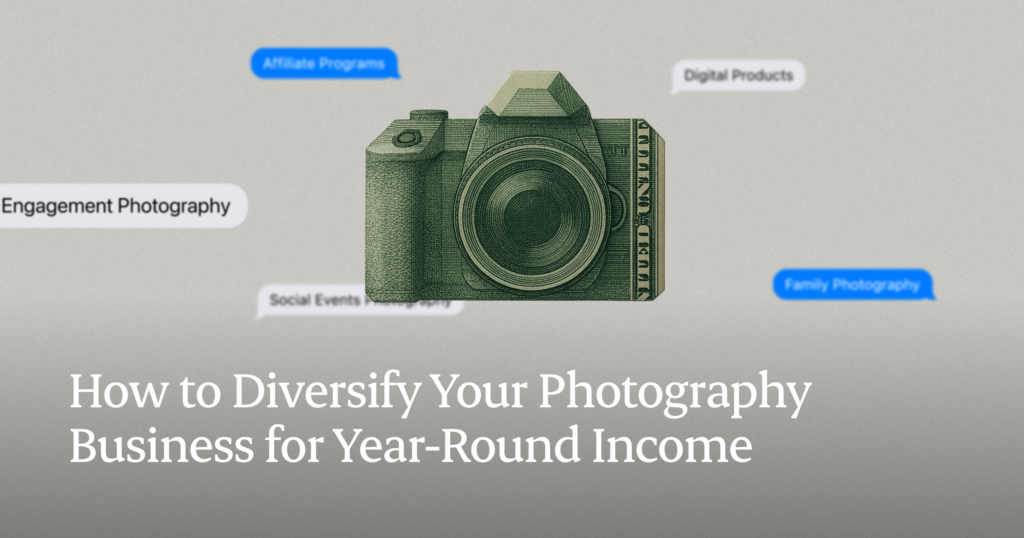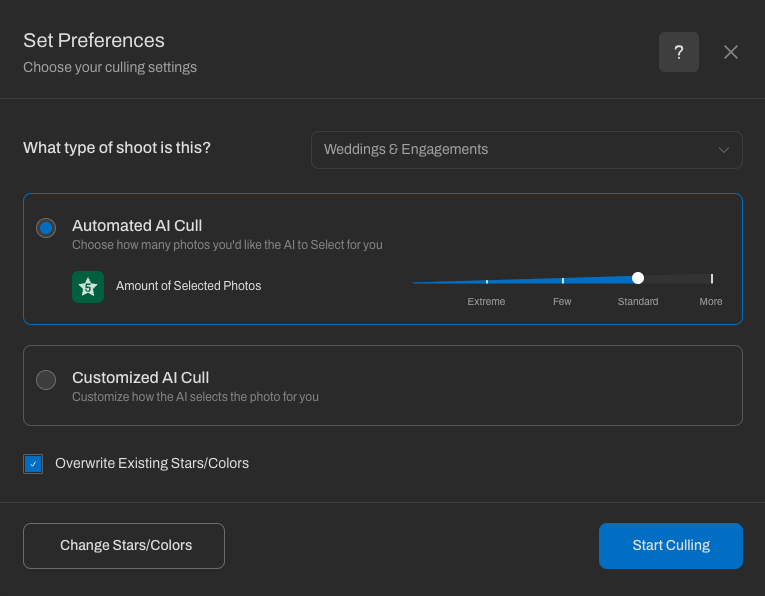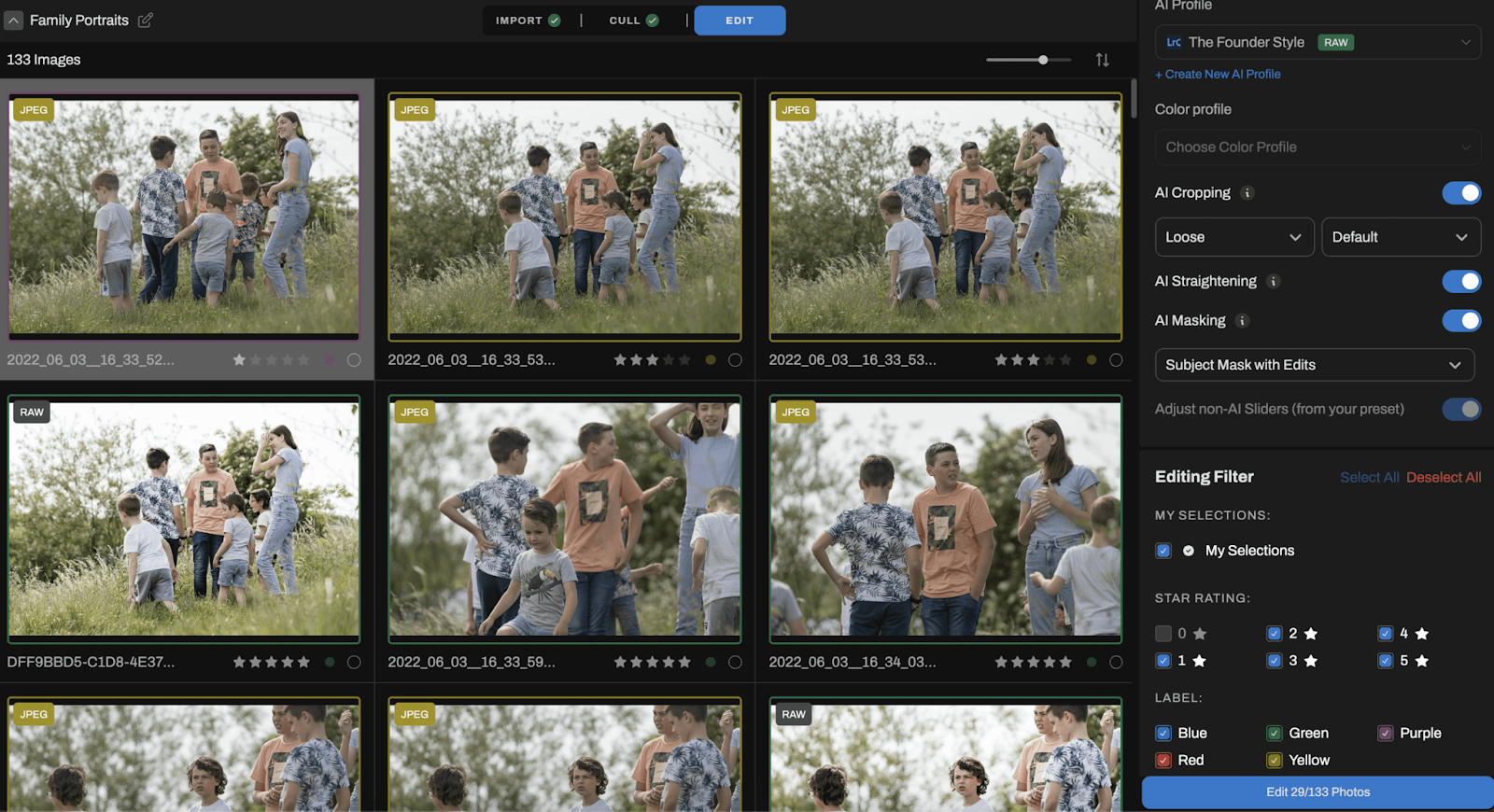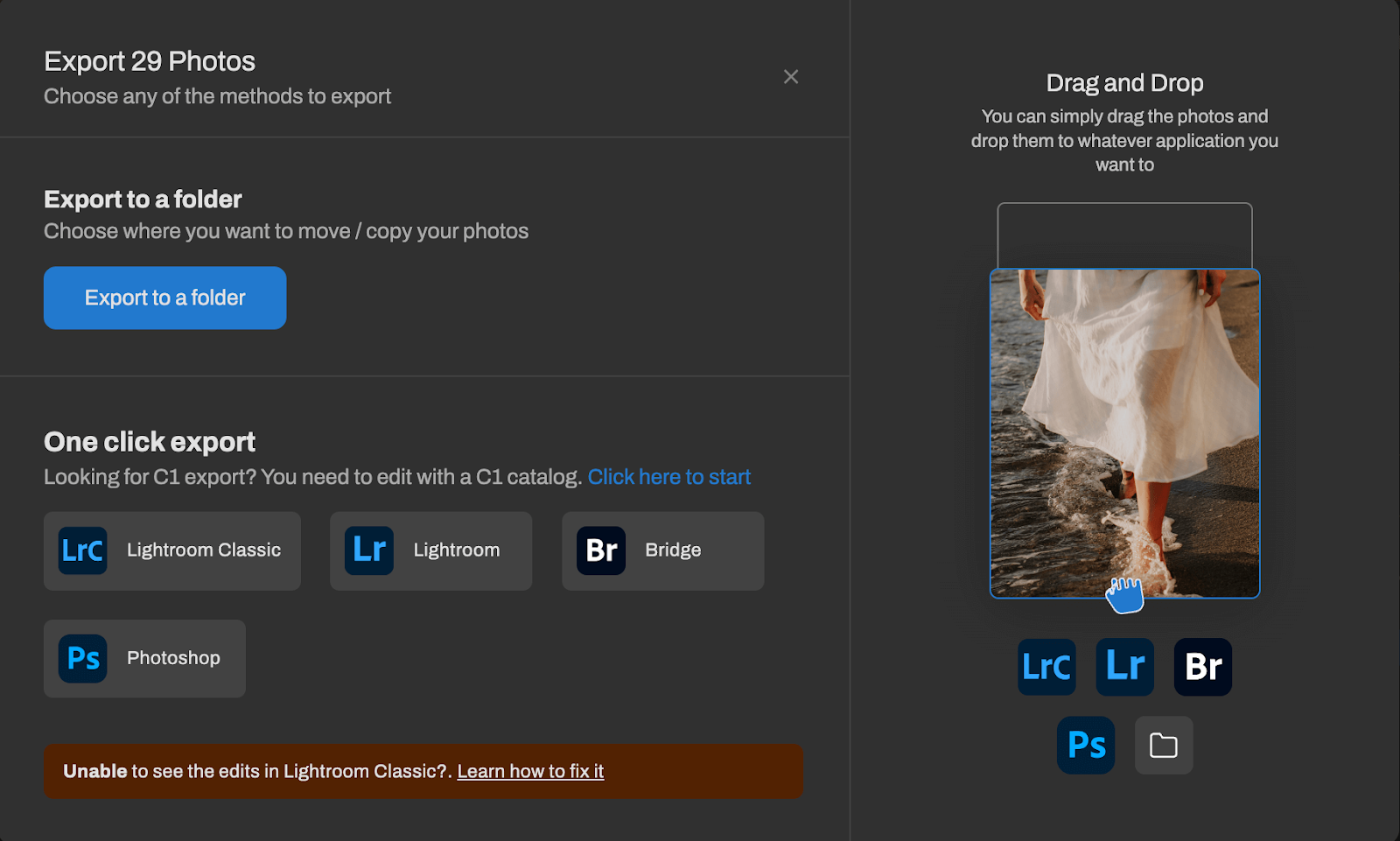8 Ways to Diversify Your Wedding Photography Business Income
Wedding photography has its ebbs and flows. During peak season, your photography business income thrives with back-to-back shoots, tight deadlines, and a steady stream of bookings. But once the season winds down, so does your net profit—and that can leave even a wedding photographer just starting out or an established professional scrambling to cover monthly fixed costs, gear upgrades, and income tax payments.
The simple answer? Build a smarter business strategy.

By expanding beyond weddings, you can reduce financial stress, tap into new creative avenues, and create a thriving photography business that runs year-round. The most important thing is to do it efficiently without burning out.
Here’s how to break out of the seasonal slump, attract new clients, and make more money doing what you love.
Why Diversification is Essential for Wedding Photographers
Wedding photography can be a gratifying and profitable career. According to Fortune Business Insights, the global wedding photography market is rising, expected to grow from $25.05 billion in 2025 to $43.60 billion by 2032.
The latest statistics from the Bureau of Labor Statistics (BLS) show that photographers generally earn a median hourly wage close to $20, though top earners make over $45.
A common hurdle professional wedding photographers must overcome is that wedding photography follows a predictable cycle: packed schedules in spring and summer, then a sharp decline in bookings during fall and winter. This rollercoaster often creates cash flow challenges, making covering year-round expenses like equipment upkeep, insurance, and editing software subscriptions tough.
Beyond seasonality, putting all your income eggs in the wedding basket makes you vulnerable to market shifts. Economic downturns, public health crises, and industry trends can cause postponements or cancellations, leaving you with little financial backup. Keeping abreast of photography industry trends can help you identify new opportunities and niches to expand your services.
Expanding into other photography niches creates steady income during wedding off-seasons. The best part? Your core photography skills transfer seamlessly between niches. No matter what type of event you’re working on, your ability to click amazing images and adapt to changing environments remains invaluable.
Diversification also fuels creative growth. Exploring new photography styles prevents burnout and sharpens your technical abilities, from mastering studio lighting to refining storytelling techniques.

These skills often elevate your wedding work, too. The lighting techniques you refine for corporate headshots can enhance bridal portraits, and the storytelling approach from family sessions can add depth to wedding albums.
8 Profitable Ways to Earn as a Photographer (Beyond Weddings)
Looking to diversify your photography business income and build a more sustainable business? Whether you're a full-time wedding photographer or just starting, these high-potential niches and passive income streams can help you generate consistent revenue year-round.
If you're starting a photography business, identifying multiple niches can help build a more sustainable model.
1. Try Engagement and Proposal Photography
This niche is a natural extension of wedding photography since you're already connected to the market. According to a recent survey by Wedissimo, the average percentage of clients who booked an engagement shoot along with their wedding shoot was 25% in 2024, an increase of 22% from 2023.
Be sure to ask about engagement sessions during the wedding booking process. They’re an easy opportunity to add value while increasing your revenue.

The scheduling also tends to be more flexible than weddings, allowing you to fit these shorter sessions into your calendar year-round.
Some tips to get you started:
- Bundle it: Offer a small discount to couples who book engagement and wedding sessions together. This will incentivize early commitment and simplify their decision-making process.
- Feature real sessions: Regularly post engagement shoots on social media and your blog, tagging venues and vendors for cross-promotion. Highlight the couple’s story to make your content more shareable.
- SEO tip: Optimize a dedicated landing page or blog post for keywords like “engagement photographer near me” or “proposal photography [city name]” to attract new clients searching for those specific services. For more SEO tips for photographers, consider optimizing a dedicated landing page or blog post for keywords specific to each of your niches.
2. Book Family and Maternity Photography Shoots
Unlike weddings, families need updated photos regularly as children grow, creating repeat business opportunities.
Your experience capturing group dynamics and managing multiple personalities during weddings transfers perfectly to family photography.

Pricing can vary widely, with photographers like Nestled in Time Photography offering maternity packages ranging from $595 to $3,695, and children's milestone and sitter sessions start at $950 per hour, highlighting the potential for premium pricing in this niche. Regardless of the niche, implementing effective photography pricing strategies is crucial to ensure profitability.
Pro Tip: Use a customer relationship management (CRM for photographers) tool to automate reminder emails annually, especially around a child’s birthday or family milestones. A simple “It’s been a year—let’s update your family photos!” email can bring in repeat bookings without extra effort.
Tools like HoneyBook or Studio Ninja make scheduling these touchpoints in advance easy.
3. Try Milestone and Social Event Photography
Think Bar/Bat Mitzvahs, Quinceañeras, Sweet 16s—celebrations that, like weddings, happen once in a lifetime and demand professional photography.
These events follow a similar structure to weddings (portraits, ceremony, reception, and candid moments) and occur year-round, helping smooth out your calendar.
Photographer LarJ, for instance, charges $1,600 for full-day coverage, with flexible half and quarter-day packages.
4. Explore Personal Branding and Headshot Photography
From entrepreneurs and influencers to executives and creatives, everyone needs standout headshots and personal branding images.

Wedding photographers are already skilled in lighting, posing, and storytelling—key strengths in this niche. As remote work and online presence continue to grow, so does demand. You can even create industry-specific packages (think: realtors, lawyers, creatives) or secure recurring corporate gigs for team photos.
Nestled in Time offers headshot sessions starting at $550 and corporate packages from $1,900, illustrating the revenue potential here.
5. Start Teaching, Mentorship & Educational Content
Photography education is a growing industry. A recent Global Information Inc. study predicts the online photography course market will reach $1.5 billion by 2030, growing nearly 10% over the next five years.
If you’ve built a successful photography career, chances are other photographers want to know how you did it. Teaching workshops, coaching, or selling digital products (like posing guides or presets) can create long-term passive profit.
Workshops, mentoring, online courses, and retreats offer long-term income and help build your brand authority. You’re not just sharing how to shoot—you’re teaching how to build a business, manage expenses, and earn a living.
Pro tip: Start small with local in-person events or one-on-one coaching before scaling to digital courses or branded retreats.
6. Set Up Passive Income Streams: Prints, Affiliates & Digital Products
Passive income can be a game-changer for photographers looking to stabilize their earnings:
- Sell Prints: Turn your favorite shots into wall art, photo books, or calendars using platforms like ShootProof or Pixieset.
- Create Digital Products: Presets, templates, posing guides, or client welcome kits can generate consistent income with a one-time effort.
- Join Affiliate Programs: Engage in affiliate marketing for photographers by promoting gear, software, or tools you love—and earn commissions. For example, the Aftershoot Affiliate Program allows you to enjoy exclusive opportunities, earn commissions, and make an impact.
7. Sell Photography Presets
If you’ve developed a signature editing style, selling photography presets can turn your creative eye into a steady passive income stream.
Photographers are always looking for ways to speed up their workflow and your presets can offer them a shortcut to polished, professional-looking edits. Whether your style is clean and true-to-color, moody and cinematic, or soft and pastel, there’s a market for it.
You don’t need a massive audience to start. Offering presets through your website, Etsy, or digital marketplaces like FilterGrade can help you reach other photographers at all skill levels. Bundle them by genre (weddings, boudoir, lifestyle), and include before-and-after examples to show your style in action.
Best of all? Once created, presets require no additional shooting, editing, or overhead — just smart marketing and a strong visual brand.
8. Offer Photography Services for Venues
If you’ve photographed weddings or events at a venue, chances are you already have a library of stunning images they could use. Offer your photography services, whether that’s updated imagery for their space, staff portraits, or styled venue shoots to showcase different setups.
Venues frequently need professional photos for brochures, websites, and promotional materials, but they don’t always have a go-to photographer. By positioning yourself as their preferred visual partner, you create opportunities for paid work that isn’t tied to client bookings.
These collaborations also help build deeper relationships with venue managers, making you more likely to receive future referrals for weddings, elopements, and styled shoots.
By diversifying your services, you can open up new income streams and build a successful photography business that can weather seasonal fluctuations.
How to Market and Brand a Diverse Photography Business
Managing the marketing for a multi-niche photography business requires strategic planning to ensure you effectively reach different target audiences without diluting your brand.
Restructuring Your Website
One practical approach to building a multi-niche photography website is to create distinct sections or pages for each niche you offer. This allows you to:
- Target specific keywords related to each specialty for better SEO performance.
- Showcase dedicated portfolios that highlight your best work in each area.
- Present service packages and pricing tailored to each type of client.
Consider creating separate online galleries that potential clients can easily navigate to find exactly what they want.
“You need to step into your ideal version of your photography brand—not your ideal version of yourself so that everything is cohesive. Clients should see your work and your website and instantly recognize the thread that ties it all together,” said pro photographer Jessica Whitaker.
The key is maintaining visual consistency across all sections. Use the same design elements, typography, and color scheme throughout your website to establish a cohesive brand identity while showcasing diverse services.
“I’ve stuck to my color palette since I started Build and Bloom in 2016. It helps me stay focused on my brand and not compare myself to others,” she added.
Even small details like the language you use, how you present your services, or how you address your audience can create a strong emotional connection.
“When I speak to my audience, I use words like we and you instead of my or I. That’s branding too. It makes people feel like they’re part of something,” Whitaker said.
Additionally, starting a photography blog can help you showcase your diverse services and attract new clients through engaging content and improved SEO.
Shifting Social Media Strategies for Diverse Offerings
When you offer services across multiple photography niches, social media can become your greatest marketing tool—or a confusing mess. To streamline your efforts, you have two main options:
Unified account strategy: Maintain a single social media presence that showcases your photography work in one place. This approach builds a stronger, more cohesive brand and helps you avoid splitting your audience.
Specialized account strategy: Create separate accounts for each niche (e.g., one for weddings, one for branding or family sessions). This allows for hyper-targeted content and messaging but requires more effort to maintain.
Cassidy Lynne, photographer and social media educator, explains it well:
“Ultimately, social media is its own form of creativity. Think of your Instagram feed like your portfolio. It should represent what you want to book more of.”
If you choose the unified approach, here are some ways to keep it clear and compelling:
- Create themed post series like Wedding Wednesday or Branding Friday to bring structure and anticipation to your feed.
- Leverage platform features like Instagram Highlights to categorize content by niche.
- Balance your posting schedule to give equal exposure to each niche you serve.
Cassidy also recommends repurposing content smartly across platforms:
“If you’re already making Reels, plop them over onto TikTok. It’s an easy 30-second add-on to your workflow.”
She emphasizes that original audio content is better for long-term engagement and cross-platform use, saying, “Trends come and go, but original audio gives your content longevity and a personal connection with your audience.”
Matching Platforms to Niches
Different platforms attract different audiences, so use this to your advantage. Instagram and Pinterest are ideal for visual storytelling—great for weddings, families, and styled shoots.
LinkedIn works well for corporate photography, branding sessions, and headshots. TikTok is a powerhouse for reaching new audiences, especially Gen Z and millennial clients who may be planning weddings, booking senior portraits, or looking for lifestyle content.
“Luxury clients are on TikTok. It sounds strange, but the couples flying you out for a destination wedding? They’re finding you on social,” Lynne claims.
Finally, don’t underestimate consistency. You don’t need to go viral; you need to show up.
“Success isn’t about a viral video. It’s about generating real bookings and hitting your goals through your content,” Lynne said, adding, "If a video goes viral, the first thing I do is post a Story: ‘Hi new followers, here’s who I am and what I do.’ Don’t ghost. Keep showing up.”
Cross-Promoting Service With Email Marketing
Email marketing is a powerful tool to cross-promote your photography services and increase revenue from your existing clients. Here’s how to make it work effectively:
- Segment your list: Organize your clients based on their past services—weddings, family portraits, and corporate work, to tailor your messaging to their specific needs.
- Craft targeted campaigns: Send personalized emails showcasing services that align with their current life stage, like offering family portraits to newlyweds.
- Highlight success stories: Share compelling examples or testimonials from clients who’ve benefited from your services to build credibility and demonstrate your expertise across various niches.
Incentivize repeat business: Offer exclusive discounts or bonuses for clients who book additional services to create a sense of urgency and reward loyalty.
Email marketing is all about keeping your existing clients engaged and your services top-of-mind to continuously expand the range of services they book with you.
Building Strategic Partnerships
Networking in different professional circles exposes you to new potential photography clients and referral sources specific to each niche you want to develop.
According to Great Big Photography World’s 2024 survey, word of mouth and referrals (61%) are the top methods by which photographers find clients. That kind of organic growth starts with the relationships you build.
“Essentially, what it comes down to is just become friends with as many people as you can in your industry—and they’re probably going to send you work,” says wedding photographer Josh Birman.
Before you start networking, clarify your brand identity. The type of work you want to book should match what you showcase and how you present yourself—online and in person.
“If you want to shoot country-style weddings, don’t show up looking like a high-fashion photographer. Your portfolio, your website, even how you dress, it all has to align with the brand you want people to remember,” Birman added.
Form partnerships with businesses that serve your target audience in each niche. For example, wedding photographers might collaborate with planners, florists, or venues. Brand photographers can work with designers, stylists, or copywriters.
“If you go above and beyond for vendors. Send sneak peeks, tag them, or even offer water to the planner on a hot day, it’s going to stick. They’ll want to work with you again,” Birman said.
Relationships with other photographers are just as valuable. If you're booked or not the right fit for a particular client, referring a trusted peer can lead to reciprocal referrals.
Styled shoots and collaborative projects also allow you to prove yourself to new contacts in a no-pressure environment, especially if you show up, deliver a great gallery, and follow up promptly.
At the end of the day, strategic networking is just genuine relationship-building. When you’re easy to work with and show up consistently, both online and offline, the referrals tend to take care of themselves.
How Can You Optimize Your Workflow for a Multi-Niche Photography Business?
Jumping between different photography genres can create several workflow bottlenecks. The sheer volume of images becomes overwhelming when handling multiple types of shoots.
Wedissimo’s survey shows that wedding photographers spend an average of two hours culling per job. This time increases with more niches in your portfolio, as each photography type has unique culling criteria.
The same goes for editing since styles and best practices vary dramatically between genres.
Step 1: Speed up your workflow with AI culling
Culling tools powered by artificial intelligence (AI) can dramatically reduce the time spent on image selection across your different photography services. Aftershoot's AI Culling tool specifically addresses the multi-niche challenge by:
- Processing images at lightning speed (up to 1,000 in under a minute).
- Identifying technical issues like blur, closed eyes, and poor exposure.

Check out this resource for a complete guide to setting up your photo-culling workflow.
Step 2: Batch Edit Photos in Your Editing Style
The real advantage for multi-niche photographers is that you can train Aftershoot's AI Editing to recognize the specific selection and editing criteria for each genre you shoot.

Whether working on weddings, branding, maternity, or events, Aftershoot allows you to create and apply custom editing profiles for each niche, ensuring visual consistency and saving time.
But if you don’t have enough data to build your own AI profile just yet, Aftershoot has you covered.
You can choose from pre-built AI editing styles designed by experienced photographers. These include everything from true-to-color portrait styles to moody or bold looks, allowing you to edit quickly without sacrificing quality.
Explore available styles here or check out examples in Aftershoot’s portrait workflow and photo editing workflow guide.
Whether you apply your style or use a pre-built one, the goal is to deliver consistently edited galleries that match your brand across multiple photography offerings.
Step 3: Export and Deliver
Once you're happy with your edits, Aftershoot makes it easy to export your images to your preferred editing software for final touch-ups or creative enhancements.
After exporting, you can prep and deliver your galleries to clients using the tools you love.
This workflow is beneficial for multi-niche photographers who want to streamline post-production and maintain a high standard across all client work, regardless of genre.
The real advantage for multi-niche photographers is that you can train the AI to understand the different selection criteria for each of your photography genres.

Once your images are culled, Aftershoot's AI Editing tool also helps optimize your editing processes by allowing you to create custom editing profiles for each photography niche.
The AI learns your preferred editing approach for each niche, ensuring consistency within each genre and allowing you to apply your signature look across each style.
Embracing New Niches to Grow Your Photography Business Income
The seasonal nature of wedding photography doesn't have to limit your photography business income potential. Diversifying your services into complementary niches can transform your business from a seasonal operation into a thriving year-round enterprise.
Of course, managing multiple photography specialties means processing more images, but this is where tools like Aftershoot become invaluable.
When you're juggling different types of photography sessions, efficiency becomes crucial. Aftershoot's AI culling can reduce post-processing time while maintaining artistic standards.
Ready to build a successful photography business? Claim your free 30-day trial on Aftershoot today.
